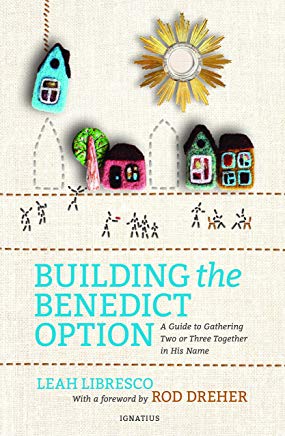by Leah Libresco
Ignatius Press
ISBN 9781621642176
reviewed by Cathy Duffy

The Benedict Option by Rob Dreher raised the issue of how Christians are to function in an increasingly anti-Christian culture. Dreher explored the causes leading up to the present state of events, but he also devotes serious attention to what might be done to buck the trends of modern society and to rebuild a Christian culture. He addresses a wide range of possible strategies such as strengthening family life, building more stable and interconnected Christian communities, returning to traditional forms of liturgy and prayer, implementing classical forms of education, and living more ascetically.
Dreher covers so much ground in his book, that someone new to considering this challenge might be overwhelmed. It’s all too easy to say, “I can’t do all of that.” That then becomes an excuse to not do anything at all.
Leah Libresco agreed with the premise of The Benedict Option and decided to do something, and that’s what she writes about in Building the Benedict Option. She decided to explore ways that she could help build stronger Christian community–what Libresco calls “thick community”–with her own friends and acquaintances. She believed that tackling that goal with bite-size efforts was realistic and practical.
Since building stronger Christian communities isn’t the sort of thing where you can find ready-made instructions and plans, Libresco knew she would be making it up as she went, but she wasn’t going to wait for the perfect plan to materialize around her! She would make it happen by planning events where people can gather to discuss, learn, and share their lives with the idea of building Christian community always in the background. As Libresco says, “In my life, and in this book, the most powerful tools I’ve found are simple: inviting friends over for dinner and praying the Divine Office, giving friends looking for work a chance to pray together (and to proofread cover letters), hosting a night of poetry recitation at a time when my friends and I felt starved for beauty” (p. 20).
Libresco plans some events for fellow believers who are part of what she calls her BenOp community, while other events are designed for broader groups. Hospitality plays a major role, and as she explains, “Creating community throws me into the paths of others, giving me more chances to learn to love them and to let them love me. I need practice in imitating Christ, so I place myself in spaces where the needs of others will be louder, where I may hear them and respond” (p.27).
Recognizing that there are legitimate obstacles—what Libresco calls enemies of the Benedict Option—she addresses many of them early in the book. Obstacles such as isolation, shrinking families, the devaluation of loving friendships without sexual overtones, people’s busy schedules, and people moving frequently can be overcome, and are even reasons of their own to pursue deeper Christian community.
In this book, Libresco takes a short-term, practical view, sharing ideas she has used that we too can try within the next week or the next month. Sometimes it’s as simple as inviting one or more people along when you are going somewhere or doing something where this is practical. Perhaps easiest of all is inviting others to join you for dinner and conversation, adding prayer if your guests are amenable.
Building the Benedict Option isn’t a recipe with specific ingredients that suit all situations. Rather, Libresco is sharing her experiments and discoveries of what has worked for her and where she ran into difficulties.
Libresco seems to associate with an academically-oriented set of friends and acquaintances who find memorizing a poem to recite for the group a manageable and comfortable activity. While activities like that might not suit every group, there are plenty of ideas to try or that might spark your own ideas. For a group whose members are practicing their faith, you might try to hold a “litany of the saints picnic” where people share about a saint who has influenced them, meet for dinner and close by praying the Divine Office together, or meet at a church for shared prayer for a special intention. For other groups, you might try some of Libresco’s other ideas: share work on a common project (maybe fueled by homemade cookies), gather to read a play together and offer optional prayer time before the main event, or watch a movie followed by a discussion. Libresco’s focus is primarily on building stronger Christian communities rather than evangelization. However, many of these events can serve as opportunities to introduce others to a life of faith.
While Libresco writes for a Catholic audience, the ideas in her book can be adapted for use across denominational boundaries. Intentionally working on building deep community relationships with one another is a challenge for anyone concerned about holding firmly to their values and passing them on to future generations in the midst of cultural opposition, but Libresco shows the way to get started.